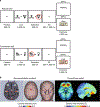High-frequency neuromodulation improves obsessive-compulsive behavior
- PMID: 33462447
- PMCID: PMC9331184
- DOI: 10.1038/s41591-020-01173-w
High-frequency neuromodulation improves obsessive-compulsive behavior
Abstract
Nearly one billion people worldwide suffer from obsessive-compulsive behaviors1,2, yet our mechanistic understanding of these behaviors is incomplete, and effective therapeutics are unavailable. An emerging perspective characterizes obsessive-compulsive behaviors as maladaptive habit learning3,4, which may be associated with abnormal beta-gamma neurophysiology of the orbitofrontal-striatal circuitry during reward processing5,6. We target the orbitofrontal cortex with alternating current, personalized to the intrinsic beta-gamma frequency of the reward network, and show rapid, reversible, frequency-specific modulation of reward- but not punishment-guided choice behavior and learning, driven by increased exploration in the setting of an actor-critic architecture. Next, we demonstrate that chronic application of the procedure over 5 days robustly attenuates obsessive-compulsive behavior in a non-clinical population for 3 months, with the largest benefits for individuals with more severe symptoms. Finally, we show that convergent mechanisms underlie modulation of reward learning and reduction of obsessive-compulsive symptoms. The results contribute to neurophysiological theories of reward, learning and obsessive-compulsive behavior, suggest a unifying functional role of rhythms in the beta-gamma range, and set the groundwork for the development of personalized circuit-based therapeutics for related disorders.
Conflict of interest statement
Competing interests
The authors declare no competing interests.
Figures





Comment in
-
The future of personalized brain stimulation.Nat Med. 2021 Feb;27(2):196-197. doi: 10.1038/s41591-021-01243-7. Nat Med. 2021. PMID: 33526929 No abstract available.
-
Transcranial alternating current stimulation for the treatment of obsessive-compulsive disorder?Brain Stimul. 2021 Jul-Aug;14(4):1048-1050. doi: 10.1016/j.brs.2021.06.014. Epub 2021 Jun 27. Brain Stimul. 2021. PMID: 34192553 Free PMC article. No abstract available.
References
-
- Robbins TW, Vaghi MM & Banca P.Obsessive-compulsive disorder: puzzles and prospects. Neuron 102, 27–47 (2019). - PubMed
-
- Marco-Pallarés J, Münte TF & Rodríguez-Fornells A.The role of high-frequency oscillatory activity in reward processing and learning. Neurosci. Biobehav. Rev 49, 1–7 (2015). - PubMed
Publication types
MeSH terms
Grants and funding
LinkOut - more resources
Full Text Sources
Other Literature Sources
Medical

